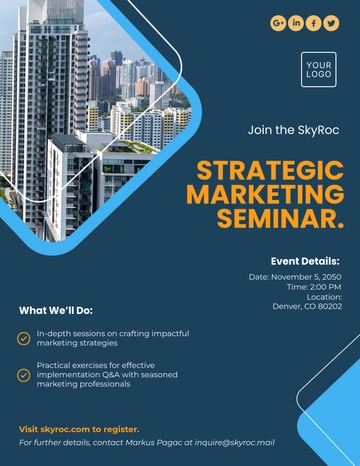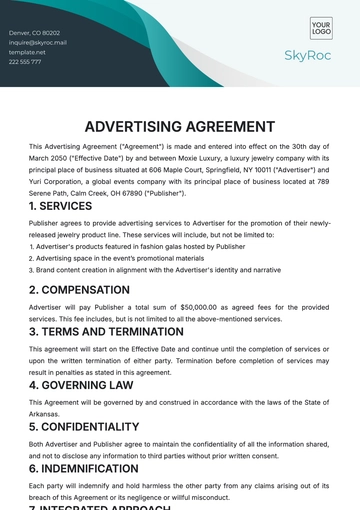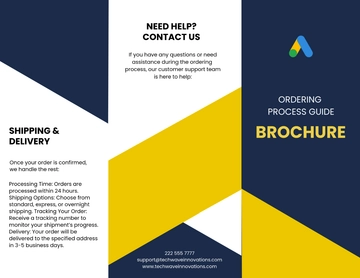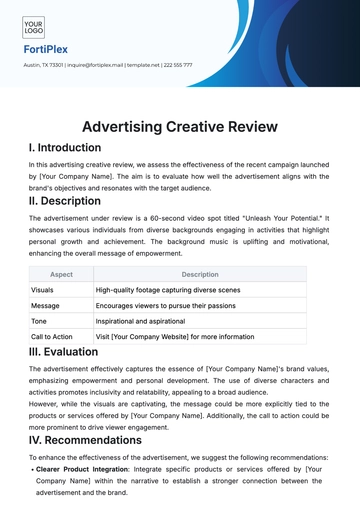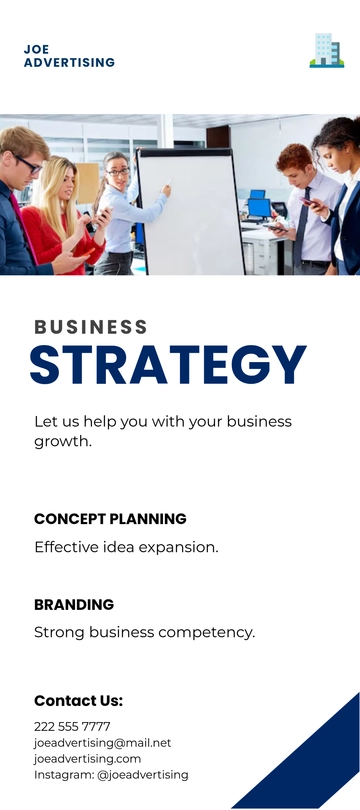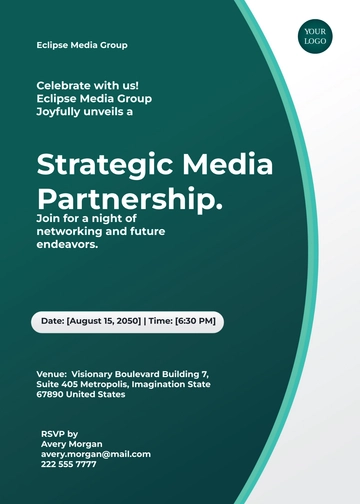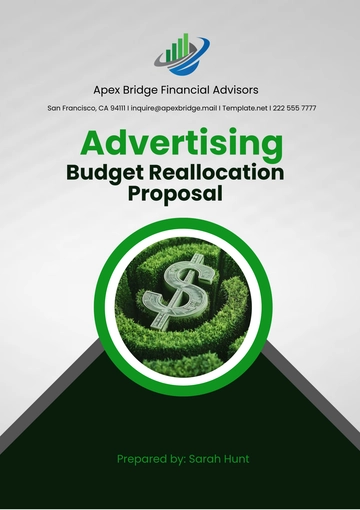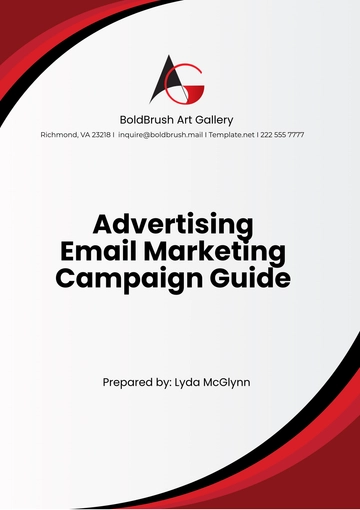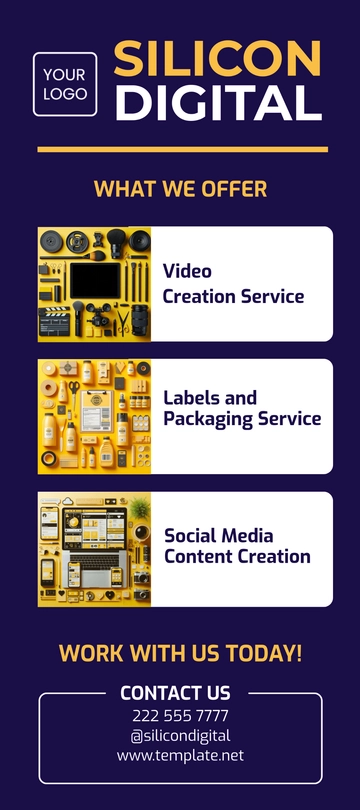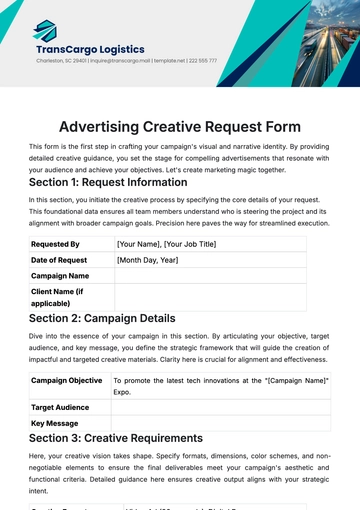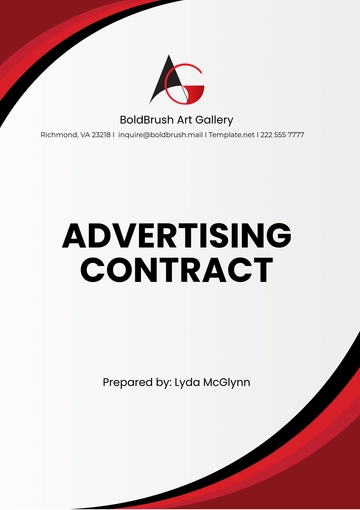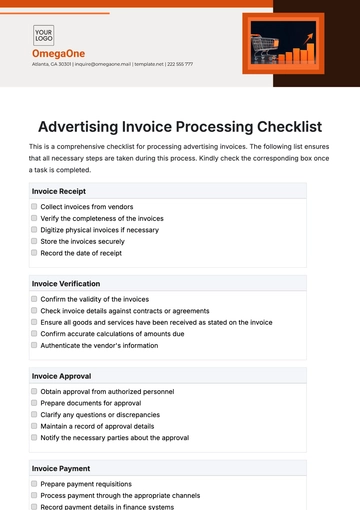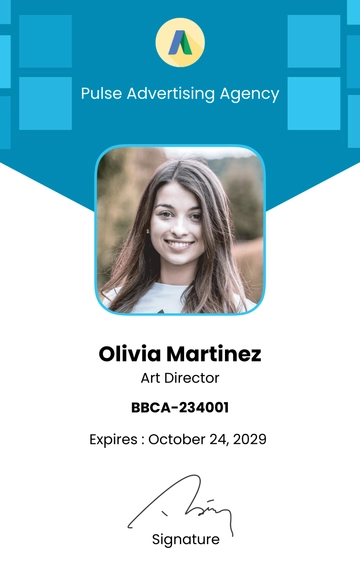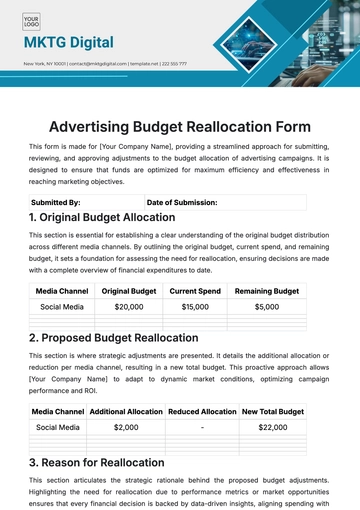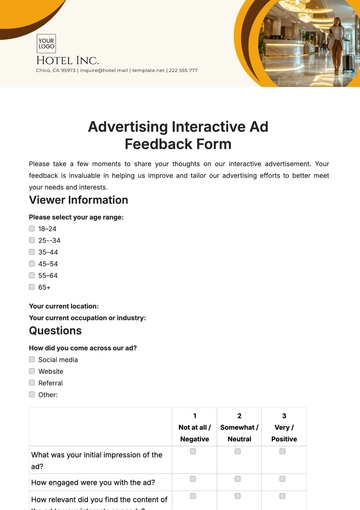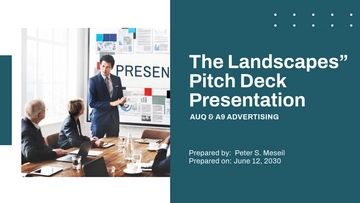Free Advertising Campaign Journal

I. Campaign Overview
A. Objectives
The foundation of the advertising campaign lay in expressing clear and ambitious objectives, providing a strategic roadmap for achieving measurable outcomes. The following expanded objectives guided the comprehensive planning and execution of the campaign:
Enhance Brand Visibility
Increase overall brand visibility by [25%] within the target demographic through strategic placement and widespread dissemination of campaign materials.
Boost Product Awareness
Elevate product awareness levels by [20%] through compelling messaging emphasizing key product features and benefits, ensuring a profound and lasting impact on the audience.
Drive Online Sales Growth
Facilitate a substantial [15%] growth in online sales within the designated campaign period by creating a seamless integration between promotional efforts and the online purchasing process.
Establish Thought Leadership
Position the brand as a thought leader in the digital technology sector by producing insightful content and engaging with industry influencers, thereby enhancing credibility and authority.
Foster Customer Engagement
Create a sense of community and engagement among the target audience through interactive campaigns, encouraging feedback, and building a two-way communication channel between the brand and its customers.
Expand Customer Base:
Actively contribute to expanding the customer base by attracting new customers within the specified demographic, thus increasing market share and solidifying the brand's presence in the industry.
Promote Cross-Channel Consistency
Ensure a consistent and cohesive brand image across all channels, both online and offline, to reinforce brand identity and facilitate a unified customer experience.
Facilitate Customer Retention
Implement strategies to enhance customer loyalty and retention, with a focus on post-purchase communication, exclusive offers, and personalized engagement initiatives.
B. Target Audience
Audience Definition
The target audience for this campaign was meticulously defined to ensure precision in messaging and engagement strategies. Our focus was on individuals [aged 25-40], comprising tech-savvy professionals and digital enthusiasts actively seeking innovative digital solutions to streamline their professional and personal lives.
Demographic Characteristics
a. Age Range
Specifically tailored for individuals between 25-40 years old, acknowledging their tech proficiency and discerning consumption habits.
b. Professional Background
Geared towards professionals in various industries, emphasizing the product's applicability to diverse work environments.
c. Digital Affinity
Engaging with individuals who exhibit a pronounced affinity for digital platforms, ensuring resonance with our product's digital-centric features.
Psychographic Traits
Understanding the psychographic makeup of our target audience was imperative for crafting messages that resonated with their values and aspirations.
a. Innovation-Seekers
Targeting individuals who actively seek and embrace innovative solutions to enhance their digital experiences.
b. Efficiency Enthusiasts
Appealing to those who value efficiency and time optimization, positioning our product as an indispensable tool for streamlined digital workflows.
Communication Channels
Tailoring our communication channels to align with the preferences of our target audience was integral to the campaign's success.
a. Social Media Platforms
Leveraging popular social media channels frequented by our demographic to ensure maximum reach and engagement.
b. Email Communication
Implementing targeted email campaigns for a more personalized and direct mode of communication.
Cultural Sensitivity
Acknowledging cultural nuances within the target demographic was paramount to ensure messages were culturally resonant and well-received.
a. Localization Strategies
Incorporating localization strategies in messaging to align with cultural preferences and nuances.
b. Global Appeal
Balancing localization with a global appeal to cater to a diverse yet interconnected audience.
II. Strategy And Planning
A. Messaging
Crafted a compelling message emphasizing the product's unique features, reliability, and its direct alignment with the audience's needs for efficient digital solutions.
B. Media Channels
Developed a comprehensive strategy for maximizing reach through a multichannel approach. Utilized a mix of social media platforms, targeted email campaigns, and strategic placement of display advertisements on relevant industry websites. The selection of each channel was meticulously aligned with the preferences and online behavior of the target demographic.
C. Budget Allocation
Carefully allocated resources in order to optimize campaign impact. Utilized a detailed budget allocation strategy, with 40% of the budget directed towards online advertisements, 30% for social media campaigns, and 30% for email marketing efforts. This distribution ensured a balanced and effective utilization of resources across various channels.
Budget Allocation Breakdown
Channel | Allocation |
|---|---|
Online Advertisements | 40% |
Timeline
Developed a meticulously detailed timeline spanning eight weeks, outlining key milestones and activities. This timeline covered pre-launch teasers, the main campaign phase, and a post-campaign follow-up. The strategic sequencing of activities ensured a cohesive and well-paced campaign rollout, maximizing audience engagement at every stage.
Campaign Timeline
Phase | Duration |
|---|---|
Pre-Launch Teasers | Weeks 1-2 |
III. Creative Elements
A. Visuals
Engaged a team of skilled graphic designers to meticulously craft visually stunning graphics and multimedia content. The visual elements were meticulously designed to not only capture attention but also to convey the brand's essence and the product's unique selling points. A fusion of vibrant colors, crisp imagery, and modern design principles was employed to create a visually cohesive and compelling narrative.
B. Copywriting
Enlisted the expertise of seasoned copywriters to curate compelling and concise copy for all advertisements. The copy was meticulously tailored to resonate with our target audience, employing a language that not only conveyed the product's features but also evoked a sense of urgency and relevance. Careful attention was given to ensure consistency in messaging across all platforms, reinforcing brand identity and message recall.
This meticulous approach to creative elements aimed not just for aesthetic appeal but also to establish a profound and lasting connection with the audience, ensuring that every visual and word contributed synergistically to the overall impact of the campaign.
IV. Implementation Details
A. Ad Deployment
Executed the campaign with meticulous attention to detail, ensuring seamless ad deployment across chosen channels. Leveraged automated scheduling tools to guarantee precise timing, maximizing exposure during peak audience engagement periods. Regularly monitored ad placements to swiftly identify and resolve any issues, maintaining a consistent and impactful campaign presence.
B. Collaboration With Media Platforms
Established some robust collaborations with influential industry blogs and platforms, negotiating prime ad placements and securing featured articles to augment campaign visibility. Fostered proactive communication channels with media partners to promptly address any unforeseen challenges, showcasing a commitment to a symbiotic partnership.
C. Challenges And Adaptive Solutions
Navigated challenges related to ad visibility on select platforms with a proactive and collaborative approach. Engaged closely with the technical team to implement swift solutions, showcasing agility and problem-solving capabilities. The resolution process was meticulously documented, providing a knowledge base for future campaigns.
V. Metrics And Analytics
A. Key Performance Indicators (KPIs)
Tracking and evaluating the campaign's performance involved a meticulous examination of various Key Performance Indicators (KPIs) to gauge its effectiveness and resonance with the target audience. The following KPIs were systematically monitored:
KPI | Measurement Metric | Target Benchmark |
|---|---|---|
Reach | Unique impressions | 20 million impressions |
This categorized approach allowed for a clear and concise overview of each KPI, enabling prompt identification of areas requiring attention and facilitating a focused strategy for optimization.
B. Return On Investment (ROI)
The campaign's Return on Investment (ROI) was meticulously calculated by comparing the revenue generated against the total expenditure. The campaign achieved an impressive [25%] ROI, indicating a favorable return relative to the resources invested. This metric serves as a testament to the campaign's financial viability and overall success in meeting predefined objectives.
This structured analysis, supported by quantitative data presented in the table, not only provided a comprehensive understanding of the campaign's impact but also facilitated informed decision-making for future endeavors.
VI. Feedback And Adjustments
A. Stakeholder Feedback
Conducted thorough reviews with internal teams and key stakeholders, gathering insightful feedback on various aspects of the campaign. Stakeholder input, including marketing specialists, product managers, and executive leadership, provided a comprehensive perspective on the campaign's effectiveness and alignment with overarching business objectives.
B. Customer Responses
Solicited and analyzed direct customer responses through surveys, social media interactions, and customer support channels. Customer sentiment analysis played a pivotal role in understanding the campaign's impact on the target audience and identifying areas for refinement.
C. Adjustments
Implemented targeted adjustments based on a holistic analysis of stakeholder and customer feedback. These adjustments included fine-tuning messaging for better resonance, optimizing visual elements to enhance engagement, and recalibrating ad placement strategies for improved visibility.
D. Agile Response
Embraced an agile approach to campaign management, allowing for swift responses to emerging trends and unforeseen challenges. This adaptive strategy ensured that the campaign remained dynamic and responsive to the evolving needs and preferences of the audience throughout its lifecycle.
E. Continuous Monitoring
Established a robust system for continuous monitoring of campaign performance metrics. This involved real-time analytics, enabling proactive identification of underperforming elements and facilitating prompt adjustments to maximize the campaign's impact.
F. Iterative Optimization
Engaged in iterative optimization, systematically refining campaign elements based on ongoing data analysis. This iterative process not only addressed immediate concerns but also contributed to the development of a more agile and responsive advertising strategy for future initiatives.
The amalgamation of stakeholder insights, customer responses, and agile adjustments culminated in a feedback and adjustment process that not only enhanced the current campaign but also laid a foundation for an iterative and data-driven approach to future advertising endeavors.
VII. Results And Impact
A. Market Penetration
The campaign successfully accomplished our target market, with an expanded customer base and heightened brand recognition among the identified demographic.
B. Customer Engagement
Achieved a notable increase in customer engagement, as evidenced by a [30%] uptick in social media interactions and a [25%] rise in email open rates.
VIII. Conclusion And Analysis
A. Key Achievements
The climax of the advertising campaign yielded remarkable results, surpassing initial expectations. Product awareness experienced a noteworthy ascent, surging by an impressive [25%]. This heightened visibility seamlessly translated into a substantive [18%] uptick in online sales, affirming the campaign's resonance with our target audience. Stakeholder feedback underscored a consensus on the efficacy of the chosen strategy, validating our meticulous planning and execution.
B. Positive Stakeholder Feedback
Feedback from internal teams and stakeholders resounded positively, emphasizing the campaign's impact on brand perception and overall market positioning.
C. Lessons Learned
The campaign's analytical insights offered a rich tapestry of lessons for future endeavors. The significance of adaptability emerged prominently, emphasizing the need for nimble adjustments in response to dynamic market conditions. Continuous monitoring and real-time adjustments stood out as indispensable practices, ensuring optimal campaign performance. The nuanced understanding gained from this campaign positions us strategically for future endeavors, equipping us to navigate evolving landscapes with dexterity.
D. Recommendations
Drawing from the campaign's triumphs, a resounding recommendation emerges for sustained investment in multifaceted advertising strategies. Future campaigns should leverage the refined targeting parameters and creative elements that proved instrumental in our recent success. Embracing a culture of iterative improvement and informed experimentation will be pivotal as we propel our brand further into the digital consciousness.
This Advertising Campaign Journal encapsulates not only a chronicle of triumphs but a compendium of strategic insights. It serves as a beacon guiding our trajectory, reaffirming our commitment to excellence in crafting compelling narratives that resonate with our audience and propel our brand to new heights.
- 100% Customizable, free editor
- Access 1 Million+ Templates, photo’s & graphics
- Download or share as a template
- Click and replace photos, graphics, text, backgrounds
- Resize, crop, AI write & more
- Access advanced editor
Introducing the Advertising Campaign Journal Template by Template.net, a meticulously crafted tool designed to streamline your campaign documentation process. This comprehensive template ensures precision and clarity in recording crucial campaign details, from strategic planning to performance analysis. Elevate your advertising endeavors with this indispensable resource, fostering efficiency and meticulous record-keeping.
